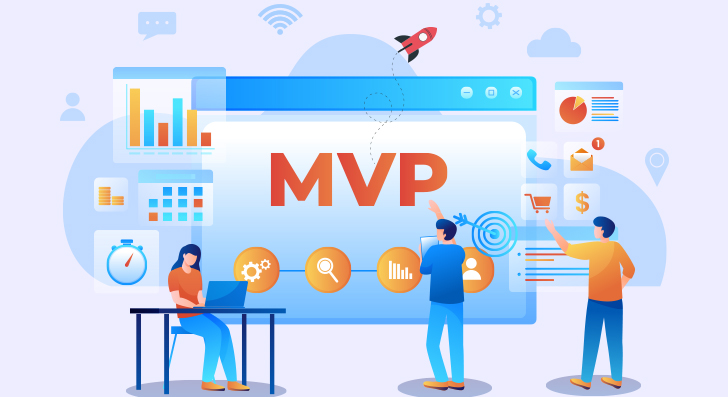Launching the right product from the outset is crucial in the fast-moving tech startup world. Minimum Viable Products (MVPs) are vital tools for startups, enabling them to test ideas, validate market assumptions, and quickly iterate based on user feedback. Despite the MVP’s importance, many startups encounter challenges that lead to costly failures. This article delves into common MVP pitfalls and offers practical strategies to help startup leaders, founders, and CEOs reduce the risk of developing the wrong product.
Table of Contents
Understanding MVP Pitfalls: Lessons from High-Profile Failures
Why Startups Struggle: Psychological and Market-Driven Traps
The Role of Competitive Analysis in MVP Development
4 Proven Strategies to Build the Right MVP
Integrating Feedback Loops for Continuous Improvement
The Impact of Timing on MVP Success
The Importance of Building a Scalable MVP
Legal Considerations in MVP Development
Leveraging Advisory Services for MVP Success
Empowering Startups to Build the Right ProductUnderstanding MVP Pitfalls: Lessons from High-Profile Failures
Even promising startups can falter at the MVP stage, as evidenced by several well-known failures and the core lessons they left behind.
Case Study: Quibi
Quibi, a short-form video streaming service, despite securing $1.75 billion in funding, failed spectacularly within six months of launching. The main issue? A lack of market validation coupled with a misguided content strategy. Quibi overestimated the market’s demand for short-form, high-production video content on mobile devices without adequately testing this assumption with real users. Core lesson here is that market validation is essential – startups must rigorously test their core assumptions with target customers before scaling.
Case Study: Juicero
Juicero serves as a classic example of overengineering. The startup created an expensive, high-tech juicer that ultimately flopped because it didn’t address a genuine consumer need. Users quickly realized they could simply squeeze a juice box by hand, making the $400 machine redundant. Juicero’s downfall highlights the dangers of prioritizing technology over user needs. Core insight here is that understanding your consumer’s actual needs is more important than dazzling them with technology.
Case Study: Google Glass
Google Glass was an innovative product with enormous potential, yet it failed to gain widespread adoption. The reason? Poor product-market fit. Although Google Glass was technologically advanced, it didn’t solve any pressing problem for consumers, and privacy concerns further alienated potential users. This case underscores the importance of ensuring that your MVP must meet a real market need. Again, key insight here is that product-market fit is non-negotiable – without it, even the most innovative products can fail.
Why Startups Struggle: Psychological and Market-Driven Traps
Creating an MVP involves avoiding traps as much as it does validating business ideas. Here are three distinct psychological and market-driven pitfalls that startups commonly face:
The Founder’s Bias
Founders often become overly attached to their ideas, leading to overconfidence and a reluctance to pivot even when evidence suggests they should. This bias can cloud judgment, making it difficult to see market realities and user feedback clearly. It’s crucial to stay objective—decisions should be driven by data, not just passion.
The Innovation Trap
Startups, in their quest to innovate, sometimes focus excessively on technology, forgetting that the primary goal of an MVP is to solve a specific user problem. Overengineering or adding features that users don’t need can lead to wasted resources and, ultimately, failure. Innovation should unambiguously serve the user — if it doesn’t, it’s just a distraction.
Market Myopia
Startups often misinterpret market signals, either by focusing on too small a niche or by ignoring critical feedback from early adopters. This short-sightedness can result in a product that, while technically sound, fails to resonate with a broader market. Listening to the market is key – ignore it at your peril.
The Role of Competitive Analysis in MVP Development
Understanding the competitive landscape is vital when developing an MVP. By analyzing competitors’ MVPs, startups can identify market gaps and avoid duplicating efforts. This analysis helps differentiate your MVP, ensuring it offers something unique or superior.
Competitive analysis isn’t just about knowing your rivals—it’s about carving out your own space in the market.
Tools and Techniques for Competitive Analysis
- SWOT Analysis: Identifying strengths, weaknesses, opportunities, and threats relative to competitors.
- Benchmarking: Comparing your MVP’s features and performance with those of competitors to pinpoint areas for improvement.
- Customer Feedback Analysis: Reviewing feedback on competitors’ products to identify central pain points and unmet needs.
4 Proven Strategies to Build the Right MVP
To sidestep these pitfalls, startups must take a strategic approach to MVP development. Here are 4 proven strategies to ensure your MVP is on the right track:
1. Lean Validation Techniques
Before heavily investing in development, startups should validate their product idea using lean methods. Techniques such as customer interviews, landing page tests, and crowdfunding can provide early insights into whether there is a genuine market demand for the product. Lean validation is about learning fast and pivoting faster — get your assumptions tested early. Eric Ries nailed it thus: “We must learn what customers really want, not what they say they want or what we think they should want.”
2. User-Centric Design
Prioritizing user feedback and needs is critical. Startups should engage with potential users early and often, incorporating their feedback into the MVP design. This ensures that the product solves real problems and resonates with its target audience. Good user experience design isn’t just a best practice—it’s integral for MVP success.
3. Iterative Development
Agile methodologies, which emphasize iterative development and frequent releases, allow startups to refine their product based on real-world feedback. By releasing early and often, startups can pivot quickly if necessary, reducing the risk of building the wrong product. The power of iteration lies in its ability to keep you aligned with market needs – don’t wait to release.
4. Data-Driven Decision Making
In the age of big data, decisions should always be grounded in evidence. Startups should leverage analytics to guide MVP iterations. Data on user behavior, engagement, and feedback can provide invaluable insights into what is working and what isn’t. This approach ensures that decisions are based on evidence rather than assumptions.
Integrating Feedback Loops for Continuous Improvement
The most successful startups are those that listen to their users and adapt quickly. Feedback loops are critical in ensuring your MVP is always aligned with market needs. Continuous feedback is essential for a successful MVP. Regularly gathering and analyzing user feedback ensures that the product evolves to meet user needs and market demands. Implementing feedback loops allows startups to pivot quickly and efficiently based on real-world data.
Useful Methods for Gathering and Analyzing Feedback
- User Surveys and Interviews: Engage directly with users to understand their experiences and gather suggestions.
- Analytics Tools: Use tools like Mixpanel, Google Analytics, or Hotjar to track user behavior and identify areas for improvement.
- Beta Testing Programs: Conduct beta tests to collect early feedback from a select group of users.
The Impact of Timing on MVP Success
Timing trumps everything in the journey of startups. A great product launched at the wrong time is likely to fail just as surely as a poor product. Market timing can significantly influence an MVP’s success. Launching too early or too late can have substantial consequences, even if the product is robust. In the words of Peter Flint: ‘Enter a market too early, no matter how strong the founding team, and you could be stuck waiting for a day that never comes. Enter too late and you’re fighting an uphill battle against incumbents with greater scale.’ Understanding market readiness and aligning your MVP launch accordingly is critical.
Case Studies of Timing-Related Successes and Failures
- Zoom: Launched during the rise of remote work, Zoom exemplifies perfect timing by addressing a market need as it emerged.
- Google Wave: An innovative product that was ahead of its time, launching before the market was ready, leading to its eventual demise.
The Importance of Building a Scalable MVP
Scalability shouldn’t be an afterthought. It needs to be baked into the MVP from the start to ensure long-term success. As a core consideration during MVP development, it allows startups to grow without needing to overhaul the entire product. Balancing lean development with scalability ensures that the MVP can handle increased user loads and feature expansions as the startup grows.
Balancing Lean Development with Scalability
- Microservices Architecture: Design the MVP with a microservices architecture to enable easier scaling and feature additions.
- Cloud Infrastructure: Use cloud services like AWS or Azure to ensure that the MVP can scale with demand without significant infrastructure changes.
- Automated Testing and CI/CD: Implement continuous integration and continuous deployment pipelines to ensure that the MVP can be updated and scaled efficiently.
Legal Considerations in MVP Development
Legal issues can derail even the most promising MVPs. Startups must consider intellectual property (IP) protection, regulatory compliance, and other legal factors during the MVP development process. Neglecting these considerations can lead to costly disputes down the road.
Key Legal Considerations
- Intellectual Property Protection: Ensure patents, trademarks, and copyrights are in place to protect your innovations.
- Regulatory Compliance: Depending on the industry, startups must comply with specific regulations, such as data protection laws in the healthcare or finance sectors.
- Contractual Agreements: Secure clear agreements with any third-party service providers or partners involved in MVP development.
Leveraging Advisory Services for MVP Success
Engaging expert advisory services early in the MVP process is one of the most effective ways to avoid pitfalls. Experienced advisors can offer invaluable insights, helping startups identify and avoid common traps, validate their product ideas, and refine their MVP for market success.
Empowering Startups to Build the Right Product
Developing the right MVP is essential for startup success. By learning from past failures, understanding psychological and market-driven traps, and adopting proven strategies, startups can significantly increase their chances of success. Additionally, leveraging expert advisory services like those offered by Damco can provide the guidance and support needed to navigate the complex MVP development process.
Key Takeaways:
- Validate your product idea before heavily investing in development.
- Focus on solving real problems for users, not just on technological innovation.
- Use data to guide your decisions and iterate quickly based on feedback.
- Consider engaging expert advisors to help refine your MVP and accelerate success.
Startups that follow these principles will be better positioned to build the right product and achieve lasting success in the competitive tech landscape.
Case Study: Damco’s Role in MVP Refinement
Damco has a strong track record of helping startups refine their MVPs. For example, a US-based technology company collaborated with Damco to migrate its inventory management platform to the Azure cloud. The result was a modernized platform that reduced infrastructure costs by 33% and significantly improved customer retention. By applying its expertise in iterative product development, Damco refined the client’s MVP, ensuring it met the market needs while allowing for scalable growth and ongoing feature enhancements.
Key Outcomes:
- Enhanced User Experience: A complete revamp of the platform’s user interface led to increased user satisfaction.
- Improved Customer Retention: The modernized platform empowered users with real-time insights and flexibility, reducing stockouts and improving inventory turnover rates by 20%.
- Cost Reduction: Cloud deployment slashed infrastructure costs by 33%, saving around $20,000 annually.
This case study demonstrates how Damco’s advisory services can transform an MVP into a successful product by addressing key challenges and leveraging the right technologies.






